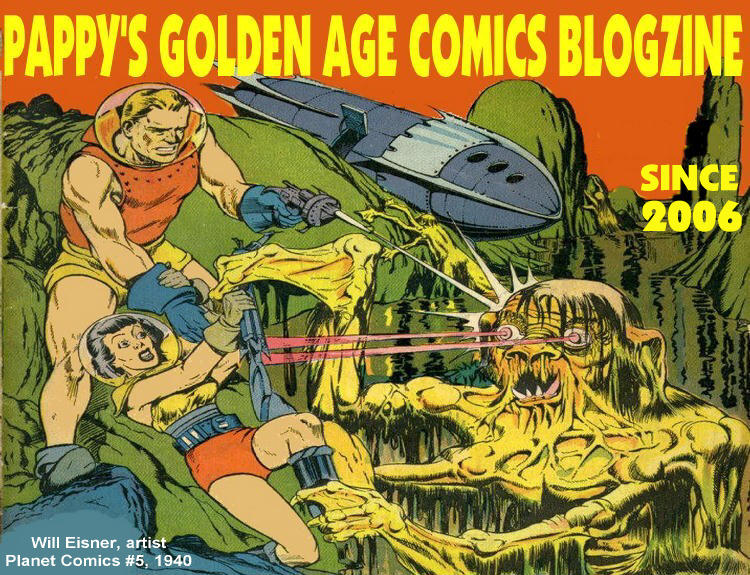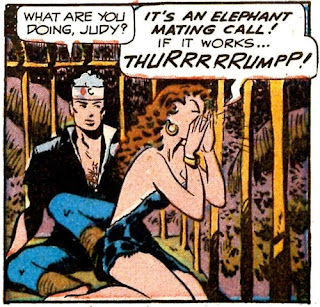“What mysterious psychological quirk motivated her crimes?” asks the splash panel blurb. To answer the question I would guess Laura, the focus of “The She-Wolf Killer,” is a psychopath. Nowadays psychiatrists would say she has an antisocial personality disorder, but yeah, to me she’s a stone-cold psychopath. In a six page story it takes nearly three before she commits her first killing, but it is easy for her, so she keeps it up until she is shot dead.
This is not a particularly well-written crime story, but it is prettied up considerably by Matt Baker’s artwork. He could turn an evil psychopath into a blonde cheesecake model, so young fellows reading might fantasize about Laura. Nice trick getting her skirt to billow above her knees. It reminds me of his work on Sky Girl in Jumbo Comics. This story is from Weird Adventures #1 (1951), from the small publisher, P.L. Publishing Co., also known as X.L. Publishing. In one of the weirdest things about Weird Adventures, it has two indicias, one for X.L., and one for P.L.
Translate
Wednesday, May 31, 2017
Monday, May 29, 2017
Number 2055: Steel Fisticuffs
Steel Fist was another short-lived superhero, with five appearances in Blue Circle Comics. This is the origin story from issue #1 (1944). Blue Circle was one of those comic books that (at least to me) looked cobbled together with left-over material from somewhere. Those were the days of paper rationing, and anyone with a ration could get into the publishing business. Comic books were great sellers during World War II, often selling out their press runs.
Characters didn’t even have to be original. Steel Fist (Timothy Slade, steelworker) got his hand dipped in molten steel by Nazi saboteurs. That must have been the same magic that a few years earlier allowed Steel Sterling to get his whole body immersed in molten steel and come out invincible. Unlike Steel, Timothy didn’t get any other super powers, but oh, baby! could he throw a wicked punch!
Henry Carl Kiefer is credited with creating Steel Fist. Kiefer was one of those older artists (born in 1890), who came into the comic book field in the thirties after working as an artist doing illustrations in pulp magazines for several years. H. C. Kiefer was familiar to me from issues of Classics Illustrated. He was also a journeyman who did artwork for many different comic book publishers. He died in 1957.
And speaking of Steel Sterling, here is his origin from Zip Comics #1. Just click on the thumbnail.
Characters didn’t even have to be original. Steel Fist (Timothy Slade, steelworker) got his hand dipped in molten steel by Nazi saboteurs. That must have been the same magic that a few years earlier allowed Steel Sterling to get his whole body immersed in molten steel and come out invincible. Unlike Steel, Timothy didn’t get any other super powers, but oh, baby! could he throw a wicked punch!
Henry Carl Kiefer is credited with creating Steel Fist. Kiefer was one of those older artists (born in 1890), who came into the comic book field in the thirties after working as an artist doing illustrations in pulp magazines for several years. H. C. Kiefer was familiar to me from issues of Classics Illustrated. He was also a journeyman who did artwork for many different comic book publishers. He died in 1957.
And speaking of Steel Sterling, here is his origin from Zip Comics #1. Just click on the thumbnail.
Friday, May 26, 2017
Number 2054: “Judy, Judy, Judy...”
Maybe it’s just me, but for a jungle girl, the name Judy just doesn’t have the ring of Sheena or Rulah or any of a myriad of exotic names for comic book white girls cavorting about dangerous jungles. Judy as cover girl, though, as shown in Alex (“Xela”) Schomburg’s sexy bondage cover — being bought by a pith-helmeted white man for a watch (from a presumed “cannibal” with cooking pot) — for Exciting Comics #59 (1948), was sure to catch the reader’s eye.
Couple of notes: Judy kills a lion, even calls him an evil jungle prowler for killing sweet little Angela the doe. Shucks, folk, the lion was obeying the law of the jungle, and Judy should have been inured to violent death in the local food chain by this time in her career.
Frank Frazetta gets credit for the artwork. Although his style peeks out, I’ll crawl a ways out on a jungle tree limb and say that another inker, or inkers, worked heavily over his pencils. Another clue is the misspelling of his name as “Frazeta” in the splash panel.
Couple of notes: Judy kills a lion, even calls him an evil jungle prowler for killing sweet little Angela the doe. Shucks, folk, the lion was obeying the law of the jungle, and Judy should have been inured to violent death in the local food chain by this time in her career.
Frank Frazetta gets credit for the artwork. Although his style peeks out, I’ll crawl a ways out on a jungle tree limb and say that another inker, or inkers, worked heavily over his pencils. Another clue is the misspelling of his name as “Frazeta” in the splash panel.
Wednesday, May 24, 2017
Number 2053: Harvey Kurtzman "saw" R. Crumb before he was born.
A little bit of elementary math here: Harvey Kurtzman was born in October, 1924...so in late 1942 he would have been 18. He drew these two stories for Super-Mystery Comics Vol. 3 No. 4, which appeared with an April 1943 cover date. (I don’t need to explain, do I, that the cover date is the date a magazine goes off sale?) So say it appeared on the comic book racks in February, 1943. The stories were usually handed in several weeks early, before the magazine was printed, for coloring and production work. “Hap Hazard,” has a startling caricature of what looks to be a person not yet born, cartoonist Robert Crumb. Depending on when Kurtzman drew this character, Crumb, who was born August 30, 1943, was either not yet conceived, or perhaps early in utero at the time Kurtzman was drawing pictures of him. Years later, of course,in the sixties, Kurtzman gave Crumb some of his first professional magazine work in Help! magazine.
It is at very least an interesting coincidence.
Kurtzman’s early work lacks polish, but not earnestness. It is fun to look at the youthful drawings of someone I respect so much. He grew as an artist so that by the late forties his mature style was well on its way, and by the fifties firmly in place.
Although "Hap" isn’t signed, Jim Vadeboncoeur Jr credits it to Kurtzman.
Here is a link to some other early Kurtzman work. Just click on the thumbnail.
Crumb with hat and glasses.
It is at very least an interesting coincidence.
Kurtzman’s early work lacks polish, but not earnestness. It is fun to look at the youthful drawings of someone I respect so much. He grew as an artist so that by the late forties his mature style was well on its way, and by the fifties firmly in place.
Although "Hap" isn’t signed, Jim Vadeboncoeur Jr credits it to Kurtzman.
Here is a link to some other early Kurtzman work. Just click on the thumbnail.
Monday, May 22, 2017
Number 2052: Green Lantern and Doiby Dickles go to a costume party
The original (if you prefer, “Earth Two”) version of Green Lantern puts on a costume over his GL costume for a party. He and his dumpy little buddy, Doiby Dickles, take on a villain from the future who landed in America in the 1940s after aiming for another time. Knodar, the villain, is the world’s last criminal! Also the dumbest for missing his time target. (Not much smarter are the future people who put the last criminal in a museum jail, rather than a real prison.)
Speaking of time, Green Lantern’s time as a forties superhero was coming to a close. With this issue, All-American Comics #100 (1948), Green Lantern was replaced on the cover by the Western hero, Johnny Thunder. A couple of issues later, All-American Western would replace the venerable flagship title of Maxwell Charles Gaines’ original comic book line, in partnership with DC Comics. Green Lantern would go on until 1949 with his own title, and until 1951 in All Star Comics, but after that would disappear until the new (if you prefer, “Earth One”) version would appear in 1959. Sheldon Mayer, who had been editor, quit that position to go back to drawing. Issue #100 was the first by editor Julius Schwartz, and the powers-that-be at DC thought some changes in the line-up were in order.
Credits by the Grand Comics Database have John Broome as writer, and Irwin Hasen the artist.
Speaking of time, Green Lantern’s time as a forties superhero was coming to a close. With this issue, All-American Comics #100 (1948), Green Lantern was replaced on the cover by the Western hero, Johnny Thunder. A couple of issues later, All-American Western would replace the venerable flagship title of Maxwell Charles Gaines’ original comic book line, in partnership with DC Comics. Green Lantern would go on until 1949 with his own title, and until 1951 in All Star Comics, but after that would disappear until the new (if you prefer, “Earth One”) version would appear in 1959. Sheldon Mayer, who had been editor, quit that position to go back to drawing. Issue #100 was the first by editor Julius Schwartz, and the powers-that-be at DC thought some changes in the line-up were in order.
Credits by the Grand Comics Database have John Broome as writer, and Irwin Hasen the artist.
Subscribe to:
Posts (Atom)


























































